The main fuse of Russian naval artillery during the Russo-Japanese War. Brink pipe
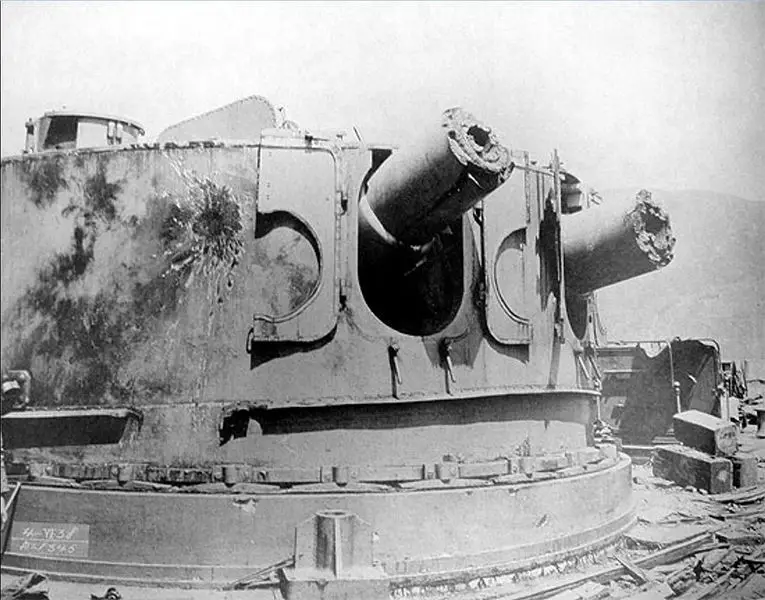
Having parsed it into previous article features of the tube arr. 1894, we move on to fuses 11DM and Brink.
Fuze 11DM
As mentioned earlier, the tubes arr. 1883 War Department and mod. 1894 of the Navy Department were intended for high-explosive shells filled with gunpowder. The 11DM fuse can be considered as an analogue of the above tubes, but for high-explosive projectiles filled with pyroxylin. It was, like the pipe arr. 1894, bottom, impact and inertial, but, unlike the latter, had a two-capsule design.
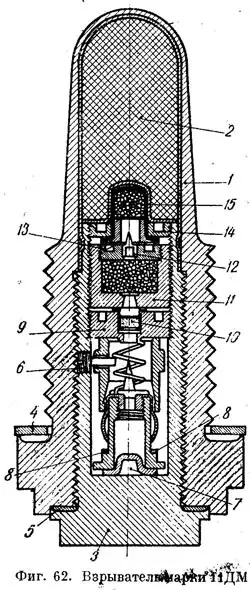
The lower part of the 11DM fuse has a similar principle of operation, but a different design with a tube arr. 1894. In the tube arr. 1894, the striker was held in a safe position by a safety spring before the shot, and when fired, the extensor carried out cocking.
In the 11DM fuse, the design of both had differences, and there was also an additional fuse - a pin (6), which was removed after the fuses were delivered to the position (V.I. Rdultovsky wrote “to the fortress”). However, the essence of the mechanism of the lower part of the fuse remained the same - after the shot, cocking was carried out: the striker was released, but was held by the force of inertia in the bottom of the tube. When hitting an obstacle, the projectile slowed down, and the striker, carried away by the force of inertia, now acting in the opposite direction (in the direction of the projectile’s flight), rushed forward.
But then the differences began. In the tube arr. 1894, the drummer hit the detonator capsule, which, when exploding, transferred the energy of the explosion to the powder filling of the projectile. In the 11DM fuse, the fire chain was more complex. The striker did not hit the detonator capsule, but the igniter capsule (10); its task was to ignite the black powder, the charge of which was pressed into the sleeve (11).
The gunpowder, burning, set the firing pin (12) in motion, which, striking the detonator capsule (15), caused it, forgive the tautology, detonation. The detonator capsule (15), in turn, ensured the detonation of the intermediate charge (2), consisting of 55,5 g of picric acid. And this picric acid itself was a detonator strong enough to make the pyroxylin in the shell explode.
Why were all these complications necessary?
To detonate a projectile filled with black or smokeless gunpowder, it was enough to ignite the gunpowder. But to detonate a projectile filled with pyroxylin, a fairly strong intermediate explosion was required, of which the detonator of the tube mod. 1894 did not provide for the Maritime Department.
As a result, the fire chain “drummer – primer – projectile powder” of the sample tubes. 1883/1894 had to be complicated to “drummer - primer - gunpowder accelerating the second striker (striking pin) - primer - intermediate charge - projectile pyroxylin" in the 11DM fuse.
Since the fire chain of the fuse is 11DM relative to the sample tube. 1894 lengthened, the time during which the projectile was detonated after touching the barrier also increased. But - not too significant, in fact, only during the combustion of gunpowder in the sleeve (11) and the movement of the striker (12), which covered the distance to the detonator no longer due to the force of inertia, but due to the expanding powder gases, that is, much faster.
If the gunpowder and firing pin had the ballistics of a Kalashnikov assault rifle cartridge, then their operating time would be something like one ten-thousandth of a second. Since black powder was used, and the design of the bushing does not resemble the barrel in any way, their “working” time was, of course, longer. But even ten times greater time gives only 0,001 s, during which a 12-mm projectile, which has an average speed of overcoming a 178-mm armor plate of about 388 m/s at a distance of 30 cables, will only travel something like 39 cm.
Therefore, it should be assumed that, other things being equal, there is a significant difference between the projectile touching the obstacle and its rupture at the sample tube. 1894 and there was no 11DM fuse. And it is not at all surprising that V.I. Rdultovsky in his “Historical sketch of the development of tubes and fuses from the beginning of their use to the end of the world war of 1914–1918.” indicated a fuse operating time of 0,005 s, which was the standard for a conventional impact inertial fuse that does not have a special deceleration.
I would like to especially note that 11DM was a Military Department fuse, and none of the sources available to me mention that the 11DM fuse was used during the Russo-Japanese War or earlier fleet. V.I. Rdultovsky points out: “Fuse 11 DM was adopted for 6- and 10-inch. shells filled with wet pyroxylin and taken from the Naval Department after the declaration of Japanese war” - that is, we are talking about coastal artillery.
Russian Imperial Navy in the period 1900–1905. used for high-explosive and armor-piercing shells or a tube mod. 1894, or a two-capsule fuse designed by A.F. Brink, which will be discussed below.
Double-capsule fuze of Lieutenant General Brink model 1896
In a previous article I referred to this tube as the “Captain A. F. Brink Design Double Action Shock Tube.” This is one of historical options for naming this pipe, and it is quite legal to use it. Unfortunately, this title has caused confusion among readers unfamiliar with the topic.
The fact is that, as I wrote earlier, naval artillery fuses of that era were divided into impact, remote and double-action tubes. The latter were a variant of a remote tube, which ensured not only the detonation of a projectile after a certain time had passed from the moment the projectile left the barrel, but also when it hit an obstacle, if it happened before the allotted time for remote detonation.
Alas, some took the phrase “double action” in the expression “Captain A. F. Brink's Double Action Shock Tube” as an indication that the tube was a double action tube. Of course, such an assumption is wrong. But, in order not to create confusion, I will henceforth refer to this tube by its other official name: “Lieutenant General Brink’s 1896 model double-capsule fuse” or, more simply, “Brink’s tube.”
Already from the name, it obviously follows that the Brink tube was two-capsule, like the 11DM fuse. The principle of their operation was also extremely similar, although the design was slightly different. In essence, the “first stage” of the Brink fuse almost completely copied the tube mod. 1894.
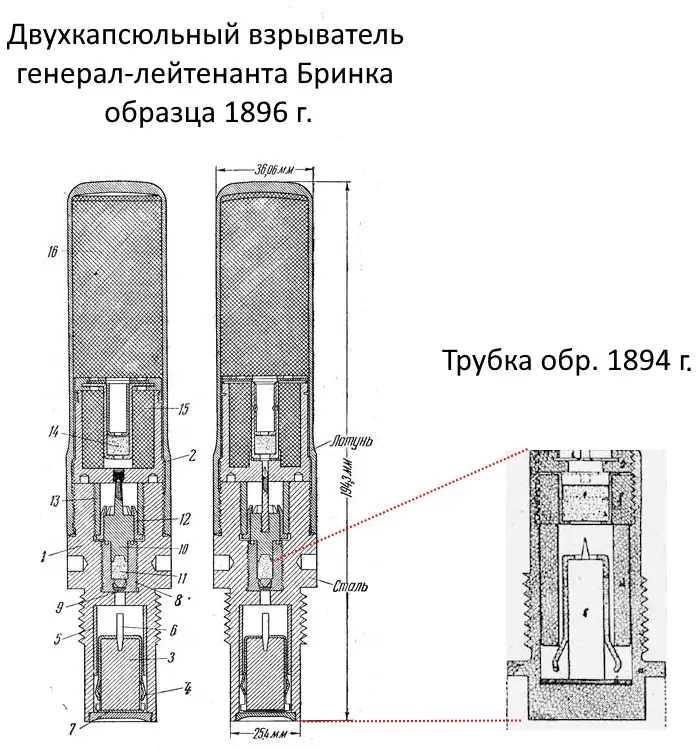
The drawings are not to scale - unfortunately, it is unknown.
After the shot, the extensor (5) acted on the safety spring (4), thereby releasing the “lower” striker (3). The firing pin of the “lower” striker (6) struck the primer, which ignited the powder firecracker (11), which accelerated the “upper” striker (10).
Before the shot, the “upper” striker (10) was kept from accidental firing by a sleeve with cut edges (12), but under the influence of powder gases, these edges, of course, easily unbent. Accordingly, the “upper” striker (10), accelerated by the powder gases of the firecracker, struck the detonator capsule (14), which consisted of mercury fulminate. The explosion energy of the capsule was sufficient to detonate two bombs (15 and 16) of dry pyroxylin, the explosion of which detonated the pyroxylin with which the projectile was loaded.
In other words, both the fire chains of the 11DM fuse and the Brink tube were extremely similar and included “a firing pin – a primer – gunpowder accelerating the second firing pin (striking pin) – a primer – an intermediate charge – gunpowder of the projectile.”
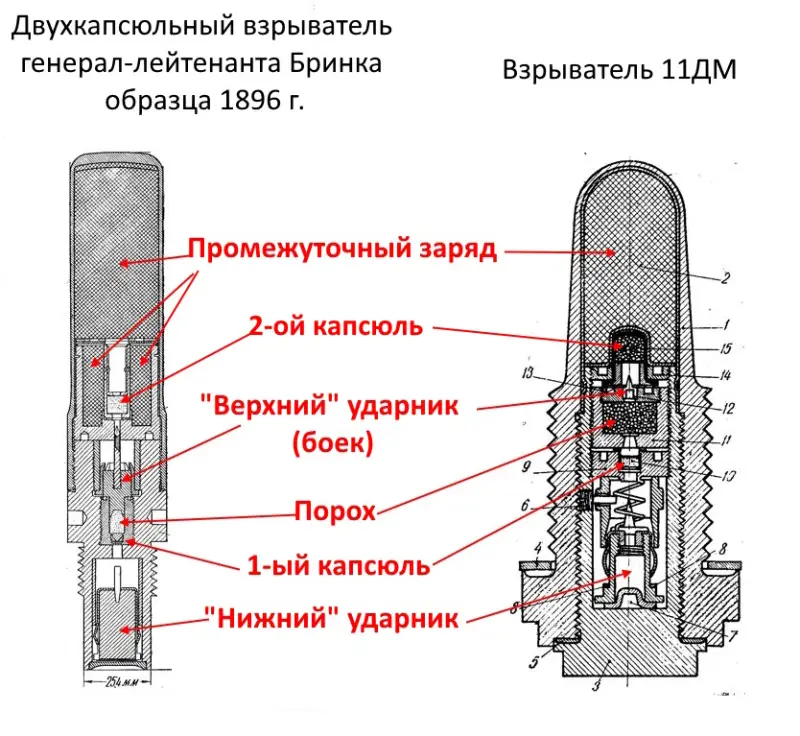
Nevertheless, the 11DM fuse provided an average deceleration of 0,005 s, while the Brink tube provided an order of magnitude more. In the article “Testing naval large-caliber shells and experimental firing at the armored compartment of ships of the Andrei Pervozvanny type” I talked about firing made by shells filled with pyroxylin. For example, one of these 12-mm caliber shells pierced a 203-mm Krupp armor plate and exploded while passing the bulkhead located behind it - that is, about 2,5 meters behind the plate.
Taking into account the fact that this projectile had a speed on the armor of 462 m/s, and with the approximate resistance of the armor plate “K” = 2, we obtain a projectile speed after overcoming the plate of 200 m/s. Accordingly, taking into account the time it takes to pass the armor plate, we can say that the Brink tube in this case provided a deceleration of approximately 62,7 seconds, that is, almost an order of magnitude longer than the standard operating time of the 0,04DM fuse. Such a deceleration (11–0,05 s) is quite typical for armor-piercing projectiles of the first half of the twentieth century: for example, Professor L. G. Goncharov, in his classification of fuses, classifies them in the “Medium deceleration” group.
So, we see that the principle of operation of the 11DM and the Brink tube is extremely similar, if not the same, but the action time of the fuse nevertheless differs by an order of magnitude.
Why could this happen?
"Tight" capsule
From the diagrams above, it is clearly visible that the stings of the strikers of the strikers of the tube arr. 1894 and the 11DM fuse were sharp, while the Brink tube had a flat tip. At the tube arr. 1894, the sting hit directly the detonator, causing its immediate initiation. In the 11DM fuse, the sting struck a highly sensitive capsule, which, after such a blow, also immediately ignited, igniting the gunpowder. But in the Brink tube, a not sharp, but flat sting struck a regular rifle capsule (9), which gave the first significant difference between the Brink tube and the above-mentioned tubes.
If the highly sensitive capsule of the 11DM fuse required an impact force of 1 g/cm to ignite, then the rifle capsule of the Brink tube required a force of 600 g/cm (according to V.I. Rdultovsky). Moreover, such a force more than eight times greater in the Brink tube had to be achieved not by a sharp, but by a flat tip of the striker.
An attempt to calculate deceleration, similar to the one I made in the previous article, without a drawing of a Brink tube and knowledge of the mass of the striker, hardly makes sense - too many assumptions will have to be made. But we can safely say that to ignite the primer, a much more powerful effect was required than in the sample tube. 1894 and fuse 11DM. This led to the fact that when colliding with a relatively weak obstacle, but one against which the sample tube. 1894 would have worked; the primer (9) would not have ignited in the Brink tube.
This suggests the following hypothesis.
Obviously, when a shell hits an enemy ship, it does not in all cases immediately hit the armor. It can first penetrate the relatively thin side plating, and only then get into the barbette, the armored cover of the chimneys, or the bevel of the carapace deck. In this case, it would probably be nice for the fuse of an armor-piercing projectile to fire not at the moment of breaking through the thin side plating, but when it hits the armor plate, in order to prevent premature rupture.
This hypothesis is logical, but perhaps still incorrect. The problem is that I have no data that could prove that the first primer of a Brink tube failed to ignite when struck by a thin barrier.
There were, of course, cases when Russian shells pierced the spar or pipes of Japanese battleships without exploding, but a shell with a delay of 0,05 s should not have exploded upon such contact - it should have exploded after those same 0,05 s after contact . Let's say a 10-inch shell from the squadron battleship Pobeda, equipped with a fuse with a delay of 0,05 s, at a distance of 40 cables should have given a gap of 20 m behind a thin barrier. Taking into account the “cone-shaped” zone of destruction by fragments, such an explosion would not have caused damage to the Japanese ship, which means it would hardly have received a mention in the report, or even would have gone unnoticed altogether.
Other cases when, for example, a 6-inch shell penetrated the Japanese “on both sides” and flew away without exploding, were not so frequent and can be attributed to defects in the fuses. And even the famous tests carried out by Rear Admiral Jessen in July 1905 (firing the cruiser Rossiya) do not give a direct answer to this question. Maybe the Brink tubes were triggered by metal junk used as a target, or maybe by hitting the ground.
In view of the above, I cannot exclude the possibility that the use of a “rifle” primer and a blunt firing pin was introduced only to prevent the detonation of the projectile when stored on a ship. But the fact is that the “tight” capsule of the Brink tube did not and could not provide a slowdown, at least any more than the capsule of the sample tube. 1894 - quite obvious.
To begin with, let us note that the mass of the firing pin and the distance from the tip of the firing pin to the primer at the sample tube. 1894 and Brink pipes are very similar. In both tubes, the capsule is ignited under the influence of the firing pin, which at the moment of impact on the capsule has a certain inertial force. This force is influenced by the mass of the striker and the difference in speeds before and after overcoming the obstacle into which the projectile hit. It is also obvious that the inertial force of the striker increases only until the projectile overcomes the obstacle.
Consequently:
1. If the resistance of the obstacle turns out to be sufficient for the striker of the Brink tube to gain enough inertial force to ignite the first primer, then ignition will occur at the same time at which detonation of the primer at the sample tube would occur. 1894.
2. If, at the moment of contact of the striker with the first primer, the striker of the Brink tube has not yet gained sufficient inertia force, but the projectile continues to slow down, then the striker will gain this force until the projectile passes the obstacle. Accordingly, the first primer of the Brink tube will either ignite while passing the obstacle, or will not ignite at all.
In other words, if two identical projectiles, one of which is equipped with a Brink fuse, and the other with a mod. 1894, hit a thick armor plate, then the first capsule of the Brink tube will ignite almost simultaneously with the detonation of the tube mod. 1894 during the passage of the plate.
If the plate is thick enough to ensure the operation of the Brink tube, but not enough for the firing pin to “reach” the primer at the moment the plate passes, then detonation of the primer of the tube arr. 1894 and the ignition of the first primer of the Brink tube will occur at an equal distance behind the stove.
And only if the resistance of the obstacle is insufficient to ignite the primer of the Brink tube, but sufficient for the sample tube. 1894, then the shell with the Brink tube will fly away without exploding, and the shell with the tube mod. 1894 will give its usual gap behind the obstacle.
Therefore, the rifle primer and blunt firing pin are not involved and do not provide retardation of the Brink tube.
Gunpowder firecracker
Apparently, the key difference between the Brink tube and the 11DM fuse, which provides deceleration, was the gunpowder in the intermediate detonator, which V.I. Rdultovsky for the Brink tube calls a “powder firecracker.”

The powder charge in the 11DM fuse, which consisted of grains of gunpowder, worked, in essence, the same way as gunpowder in a conventional cartridge. When ignited from the primer, the thermal impulse spread very quickly throughout the entire powder charge in the cartridge case, individual grains burned immediately over the entire area, the pressure under the influence of the released gases increased like an avalanche, accelerating the combustion process. The role of the bullet in the cartridge was played by the firing pin (12).
At the same time, a firecracker could be made from pressed gunpowder, essentially representing a gunpowder bomb. In this case, it would burn much more slowly than grain gunpowder of the same mass, since the flame would not cover the surface of the powder grains along the entire length of the firecracker, only its edge facing the primer would burn. A slow-burning type of gunpowder could also be used, or a fast-burning one, but subjected to a phlegmatization procedure - that is, impregnated with a composition that reduces its burning rate. It should be assumed that all this, together or separately, provided the Brink tube with an action time of 0,04–0,05 s, sufficient for the projectile to explode behind the armor plate, and not in the process of overcoming it.
The hypothesis that the fuses used gunpowder with different effects is confirmed by the design of the 5DM fuse, which is also given by V.I. Rdultovsky. This fuse is identical in almost all respects to the 11DM, with the exception of the presence of a powder moderator (5) in the 12DM.
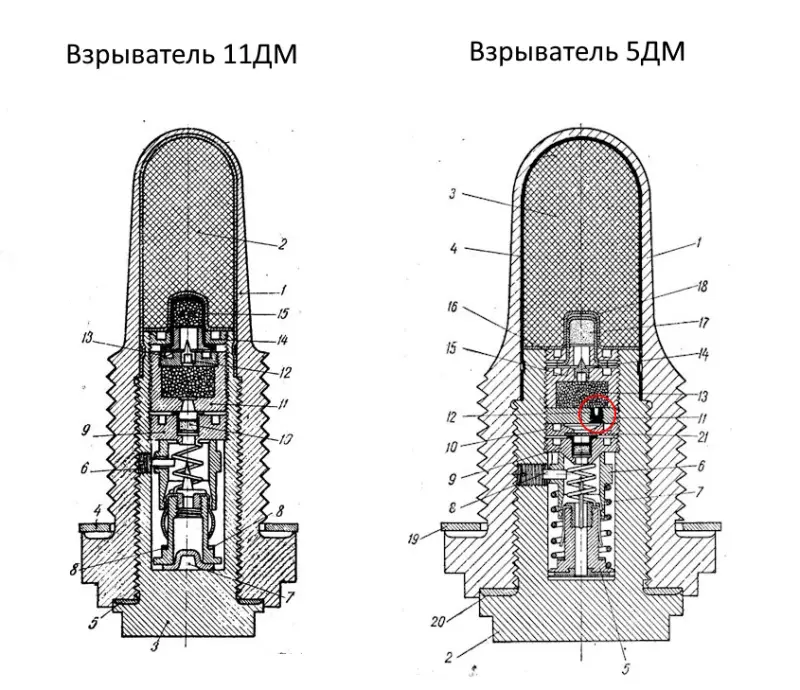
Moreover, as V.I. Rdultovsky points out, the operating time of 11DM is 0,005 s, and 5DM is generally 0,25–0,5 s. It is also obvious that the size of the powder moderator could not provide such a slowdown if it were made from the same gunpowder that was used in the 11DM fuse.
The igniter caps for the 11DM and 5DM fuses are identical, respectively, the thermal impulse (300 m/s) will reach the gunpowder in the 11DM and the powder moderator in the 5DM almost simultaneously. And if the same gunpowder was used in the powder moderator, then a small “gasket” in the form of a powder moderator could not possibly slow down the operation of the fuse from 0,005 s to 0,25–0,5 s.
Consequently, at a minimum, the powder retarder had a powder different from that used in the 11DM fuse, and providing greater retardation. And if so, then no one could stop the Navy Department from equipping the two-capsule fuses with a powder squib, which slowed down the action of the fuse relative to the gunpowder used in 11DM.
On criticism of the Brink pipe
The following are usually mentioned as complaints about Lieutenant General Brink's 1896 model two-capsule fuse:
1. Use of Brink tubes in high-explosive shells.
2. Technical imperfection of fuses.
Obviously, the use of double-capsule fuses with a delay of 0,04–0,05 s for high-explosive projectiles turned such projectiles into poor armor-piercing ones, since, unlike real armor-piercing ammunition, their cases did not have sufficient strength to consistently penetrate armor, even smaller thickness than armor-piercing ones. This did not, of course, make such shells completely useless: in describing the damage to Japanese ships, we often come across cases where shells equipped with a Brink tube nevertheless exploded inside Japanese battleships and armored cruisers, causing some damage to the latter. But it is no less obvious that the fuse cannot be reproached for its use for other purposes.
Another thing is the list of technical shortcomings of Lieutenant General Brink’s double-capsule fuses, which V. I. Rdultovsky gives, namely:
1. Poor fuse action when colliding with a weak barrier or falling into water.
2. Too soft firing pin (10) - this part of the fuse was made of aluminum, which originally contained impurities, and was therefore harder than pure aluminum. Subsequently, when they learned to make aluminum without impurities, it turned out to be too soft and sometimes did not ensure ignition of the primer upon impact.
3. Verbatim: “When hitting thicker plates, the front part of the fuse could break off due to the low strength of the connection with the body. This created an unsecured fuse action.”
The first drawback cannot be considered as such if the use of a “tight” capsule was a conscious decision that made it possible to ignore light obstacles and ensure that the tube would fire only when it encountered the ship’s armor. In this case, it must be stated that the decision was erroneous, not the design. If the rifle fuse and blunt firing pin were used solely to prevent the detonation of the projectile during storage, then yes, this was, of course, a drawback.
The rest... Both the soft firing pin and the broken body meant that the fuse would not have worked. At the same time, the data I have speaks very well about the operation of Brink fuses.
In all three cases of firing pyroxylin-filled shells into the 1904-mm armor plate of the Andrew Pervozvanny-class battleship that took place in 203, the Brink tubes obviously experienced an extremely strong blow, but they worked without a flaw. During experiments conducted on June 13, 1905, Rear Admiral Jessen fired 7 shells with Brink tubes, and only one of them did not explode, ricocheting off the ground. It is quite obvious that the same fuses were used in these firings as in the Russo-Japanese War, and such results do not at all indicate the poor quality of the two-capsule Brink tubes.
V.I. Rdultovsky believed that the permissible percentage of fuze failures should not exceed 5%, and, probably, the technical imperfections he pointed out led to the fact that for Brink tubes this figure was slightly higher. But, obviously, not to such an extent as to render our armor-piercing shells useless.
Conclusions
While working on a series of articles devoted to armor and shells of the Russo-Japanese War, I came to the conclusion that the Russian Imperial Navy had first-class 12-inch armor-piercing shells and fuses for them. But, unfortunately, due to the capabilities of the artillery of those years, they could become a decisive force only at relatively short distances of artillery combat, 15–20 cables maximum. And in order to converge on such distances, either the consent and willingness of the enemy to fight at them was required, or squadron speed exceeding that of the enemy and allowing him to impose these distances.
Alas, the Russian fleet had neither one nor the other. The Japanese, using shells whose explosions were very clearly visible and made it possible to effectively adjust the fire, relied on increasing the firing distance to 30 cables or more, converging at shorter distances only accidentally and briefly, or when the fire of our ships was already suppressed by them. At long distances, we were forced to respond to them with our high-explosive shells, which turned out to be much weaker than the Japanese ones - but this is the topic of a separate series of articles, which I will certainly get to someday.
The armor-piercing shells of the Russian Imperial Navy did not play a noticeable role in the Russo-Japanese War, not because they were bad, but because our fleet was unable to provide the necessary conditions for their effective use, that is, convergence over short distances.
In conclusion, I present to the respected reader a table of the distances for a projectile to pass behind a plate before the explosion for a fuse with a standard deceleration of 0,04 s for Krupp armor of various thicknesses.
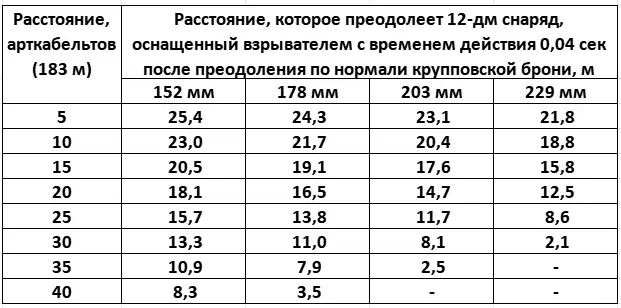
You need to understand, of course, that when hitting a ship, the indicated distances will be significantly shorter, because after overcoming the same armored belt, the projectile can hit the slope of the armored deck or a coal pit with coal, and even if not, it will meet steel bulkheads on its way, and that’s all these obstacles will slow down its movement.
And, of course, we must never forget that the fuses of those years had very large tolerances for their operating time, so that the Brink tube, like the Baranovsky tube, could cause either a premature rupture or a projectile detonation with a large delay from the time allotted to him.
Information